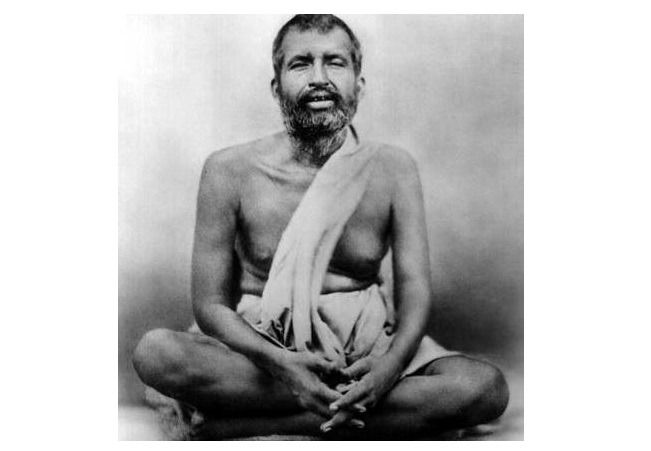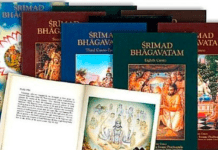Sri Ramakrishna Paramahansa was a revered Indian Hindu mystic and spiritual luminary of the 19th century. Born in 1836 in the village of Kamarpukur in West Bengal, India, his life became a beacon of divine wisdom and universal love. He is considered a key figure in the revitalization of Hinduism in the late 1800s. His profound spiritual journey led him through the diverse realms of Hindu traditions, encompassing Vaishnavism, Tantra, and Advaita Vedanta, as well as explorations into Islam and Christianity.
His teachings, conveyed through parables, emphasized the essential unity of all religions, proclaiming them as diverse paths converging towards a singular divine goal. Sri Ramakrishna is best known for his intense spiritual practices and his teachings on the universality of religions. He emphasized the idea that all religions are paths leading to the same ultimate truth.
Childhood and Early Life of Sri Ramakrishna Paramahansa:
Birth and Childhood:
Sri Ramakrishna Paramahansa, born on 18 February 1836, in the village of Kamarpukur in the Hooghly district of West Bengal, India, emerged into a world of poverty and piety. The youngest of four siblings, he was born into a devout Brahmin family to Khudiram Chattopadhyaya (born 1775) and Chandramani Devi (born 1791). The family’s ancestral property in Dere Village was unjustly seized by an unscrupulous landlord, Ramananda Roy, leading the family to relocate to Kamarpukur. Despite the financial challenges, the family remained steadfast in their devotion to the Hindu deity Rama.
Family Devotion to Rama:
The Chattopadhyaya family was ardent devotees of the Hindu deity Rama, with the family deity being Sri Raghubir, an epithet of Rama. This devotion was reflected in the names given to Khudiram and Chandramani’s male offspring: Ramkumar, Rameswar, and Ramakrishna.
Origin of the Name “Ramakrishna”:
The family’s commitment to Lord Rama was reflected in the names of their male children, all starting with “Ram” or “Rama.” There has been some debate about the origin of the name “Ramakrishna,” but evidence supports that his father bestowed this name upon him.
Education and Early Disinterest:
Ramakrishna’s formal education began in the village school, where he learned basic reading and writing skills. However, his aversion to arithmetic prevented him from progressing beyond simple mathematical concepts. He immersed himself in religious texts like the Ramayana and the Mahabharata, fostering a deep sense of devotion. Disillusioned by the scholars’ pursuit of wealth over righteous conduct, he lost interest in what he termed “bread-winning education.” Instead, he honed his skills in image-making, acting, and painting.
Artistic Pursuits and Drama Group:
Displaying proficiency in various artistic endeavors, Ramakrishna’s talents extended beyond academic realms. At the age of fourteen, he founded a drama group with friends, a venture that led him to leave formal education behind. His departure from traditional schooling marked the beginning of a more unconventional path.
Encounters with Renunciates and Spiritual Practices:
Living in Kamarpukur, a transit point for pilgrimage routes to Puri, exposed Ramakrishna to renunciate saints and holy men. He became well-versed in Hindu scriptures, including the Puranas, the Ramayana, the Mahabharata, and the Bhagavata Purana, learning from wandering monks and Kathaks who preached and sang the Puranas. Ramakrishna shared these teachings with village women, using songs and enactments.
Challenges to Social Norms:
Ramakrishna’s unconventional approach extended to social norms. His challenge to the strict purdah enforced by a trader, Durgadas Pyne, demonstrated his belief in the empowerment of women through education and devotion to God rather than through seclusion. Ramakrishna even accepted a challenge to enter Durgadas’s inner apartments in disguise, successfully breaking the barriers imposed on women.
Shift to Calcutta and Family Responsibilities:
Following the death of his father in 1843, Ramakrishna, at the age of seven and a half, became more reticent. As family responsibilities fell on his elder brother, Ramkumar, who was significantly older, the family faced financial hardships. In response, Ramkumar started a Sanskrit school in Calcutta and served as a priest there. In 1852, Ramakrishna moved to Calcutta to assist his brother in priestly duties, marking a pivotal shift in his life.
Marriage to Saradamoni Mukhopadhyay:
In 1859, at the age of twenty-three, Sri Ramakrishna entered into a union that transcended the ordinary bounds of matrimony. His bride was five-year-old Saradamoni Mukhopadhyay from a neighboring village. The marriage was unconventional by contemporary standards, and the couple stayed apart until Saradamoni reached the age of eighteen. It was then that she joined her husband at Dakshineswar, and Ramakrishna proclaimed her as the embodiment of the Divine Mother. The sacred Shodashi Puja, performed with Saradamoni at the seat of Goddess Kali, symbolized their spiritual union. Saradamoni embraced her role as a devoted follower of her husband’s philosophies and seamlessly took on the responsibility of being a mother figure to his disciples.
Spiritual Attachment:
Arrival at Dakshineswar and Induction into Priesthood:
The journey of Ramakrishna’s priesthood began at the Dakshineswar Kali Temple, established in 1855 by Rani Rashmoni. Facing challenges in finding a priest due to her lower caste background, Rani Rashmoni sought Ramkumar, Ramakrishna’s elder brother, as the head priest. Ramakumar invited Ramakrishna to assist him in the daily rituals at Dakshineswar. After Ramkumar’s death in 1856, Ramakrishna assumed the position of the head priest.
Mathurbabu, Rani Rashmoni’s son-in-law, was impressed by Ramakrishna’s piety and supernatural incidents. Witnessing these qualities, Mathurbabu gave him the name Ramakrishna. Ramakrishna’s deep devotion and spiritual journey unfolded as the chief priest at Dakshineswar.
Spiritual Journey:
Bhakti towards Lord Rama and Introduction to Kali Worship:
Ramakrishna’s spiritual journey began with a foundation in Bhakti towards Lord Rama. However, his duties as a priest at the Dakshineswar temple led him to embrace the worship of Mother Kali. During this time, encounters with itinerant sadhus enriched his understanding as they initiated him into various schools of Hinduism.
Initiation into Tantra by Bhairavi Brahmani (1861-1863):
In 1861, Ramakrishna’s spiritual exploration took a tantric turn under the guidance of Bhairavi Brahmani, a female ascetic. He engaged in sixty-four major tantric sadhanas, completing each in just three days. This phase involved mantra rituals, purifying the mind, and venturing into vamachara practices. Although he did not directly participate in some activities, he acknowledged the left-hand tantric path as a valid means to God-realization.
Vaishnava Bhakti and Practices (1864):
Under the tutelage of Jatadhari, a Vaishnava guru, Ramakrishna practiced vātsalya bhāva, worshipping a small metal image of Ramlālā. He felt the presence of child Rama as a living God in this metal image. Later, he delved into madhura bhāva, adopting the attitude of the Gopis and Radha towards Krishna. This practice involved dressing in women’s attire and culminated in savikalpa samadhi—vision and union with Krishna.
Exploration of Sufism (1866) and Christianity (1873):
In 1866, Ramakrishna’s spiritual journey extended to Islam under the guidance of Hindu guru Govinda Roy, who practiced Sufism. His exploration of Christianity occurred in 1873 when a devotee read the Bible to him. During this period, he had visions of Madonna and Child and of Jesus himself.
Settling into Bhavamukha:
After more than a decade of diverse sadhana in various religious paths, Ramakrishna’s personal practices settled. He entered a state known as bhavamukha, a level of blissful samadhi. His routine included meditation in the Panchavati, offering flowers and incense in the Kali temple, and contemplating various deities and religious figures.
Tota Puri and Vedanta (1864):
In 1864, the arrival of Tota Puri, a Vedanta monk, marked a significant phase. Despite initial skepticism about Ramakrishna’s devotion to Mother Kali, Tota Puri initiated him into sannyasa at the Panchavati. Through various rites and ceremonies, Ramakrishna renounced worldly desires and accepted the ochre cloth of a Sannyasi.
Ramakrishna’s spiritual odyssey unfolded as a tapestry of diverse practices, transcending the boundaries of traditional paths and embodying the essence of universal spirituality.
Teachings and Influence on Society:
1. Universal God-Realization:
Sri Ramakrishna’s teachings centered on the universal pursuit of God-realization. He emphasized that different religions were diverse paths leading to the same ultimate goal—God. His simplicity and childlike enthusiasm made complex spiritual concepts accessible through parables, stories, and anecdotes.
2. Sri Sri Ramakrishna Kathamrita:
His conversations with disciples, recorded by Mahendranath Gupta in “Sri Sri Ramakrishna Kathamrita” (The Nectar of Sri Ramakrishna’s Words), became a valuable repository of his teachings. In this work, he expounded on the depth of his belief in the Divine and shared his experiences of embracing God in a tangible form.
3. Social Equality and Castelessness:
Ramakrishna actively challenged caste distinctions, eating food cooked by lower castes to dispel the notion of belonging to a higher Brahmanical caste. He advocated social equality and welcomed devotees without discrimination based on caste or background.
4. Influence on Bengal’s Spiritual Renaissance:
In the nineteenth-century Bengal, Ramakrishna played a pivotal role in revitalizing Hinduism, which was facing challenges. His teachings influenced not only his immediate disciples but also had a profound impact on broader religious movements, including Brahmoism. He prompted a reevaluation of beliefs within the Brahmo Samaj.
Notable Disciples:
1. Swami Vivekananda (Narendranath Datta):
Foremost among Ramakrishna’s disciples was Swami Vivekananda, who played a key role in globalizing Ramakrishna’s philosophy. He founded the Ramakrishna Mission in 1897 to implement his Guru’s visions and dedicated it to serving society.
2. Other Renunciate Disciples:
Several disciples renounced family life and contributed to the formation of the Ramakrishna Math. Notable among them were Swami Abhedananda (Kaliprasad Chandra), Swami Ramakrishnananda (Sashibhushan Chakravarty), Swami Brahmananda (Rakhal Chandra Ghosh), and Swami Saradananda (Sarat Chandra Chakravarty). They propagated Ramakrishna’s teachings globally and carried forward his vision of selfless service (Seva).
3. Influence on Brahmo Samaj Leader Keshab Chandra Sen:
Ramakrishna profoundly affected Keshab Chandra Sen, an influential Brahmo Samaj leader. Sen rejected the rigidity of Brahmo ideals under Ramakrishna’s influence, leading to the Naba Bidhan movement within the Brahmo order. He popularized Ramakrishna’s teachings among the elite of Bengali society through his periodicals.
4. Impact on Various Professions:
Ramakrishna’s influence extended beyond spiritual circles. Disciples like Mahendranath Gupta (a family man and devotee), Girish Chandra Ghosh (a noted poet, playwright, and theater personality), Mahendra Lal Sarkar (a successful homeopath doctor), and Akshay Kumar Sen (a mystic and saint) showcased the diversity of professions touched by his teachings.
Sri Ramakrishna’s teachings, embodied by his disciples, continue to inspire spiritual seekers and contribute to the cultural and social fabric of society.
Death:
In 1885, Sri Ramakrishna faced the challenges of throat cancer. Seeking the best medical care, his disciples moved him from Dakshineswar to a devotee’s residence in Shyampukur, Calcutta. As his health continued to decline, he was later relocated to a larger house in Cossipore.
Unfortunately, despite medical efforts, Ramakrishna’s condition worsened. On August 16, 1886, at the Cossipore garden house, Sri Ramakrishna breathed his last. His passing marked the end of a remarkable life dedicated to spiritual exploration, universal teachings, and the pursuit of God-realization.
Conclusion:
Sri Ramakrishna Paramahansa’s life was a testament to the transformative power of spirituality and the universality of divine realization. His teachings continue to inspire millions worldwide, emphasizing the unity underlying the diversity of religious expressions. The legacy of this spiritual luminary endures, inviting seekers on a journey toward self-discovery and a deeper understanding of the divine.





















































